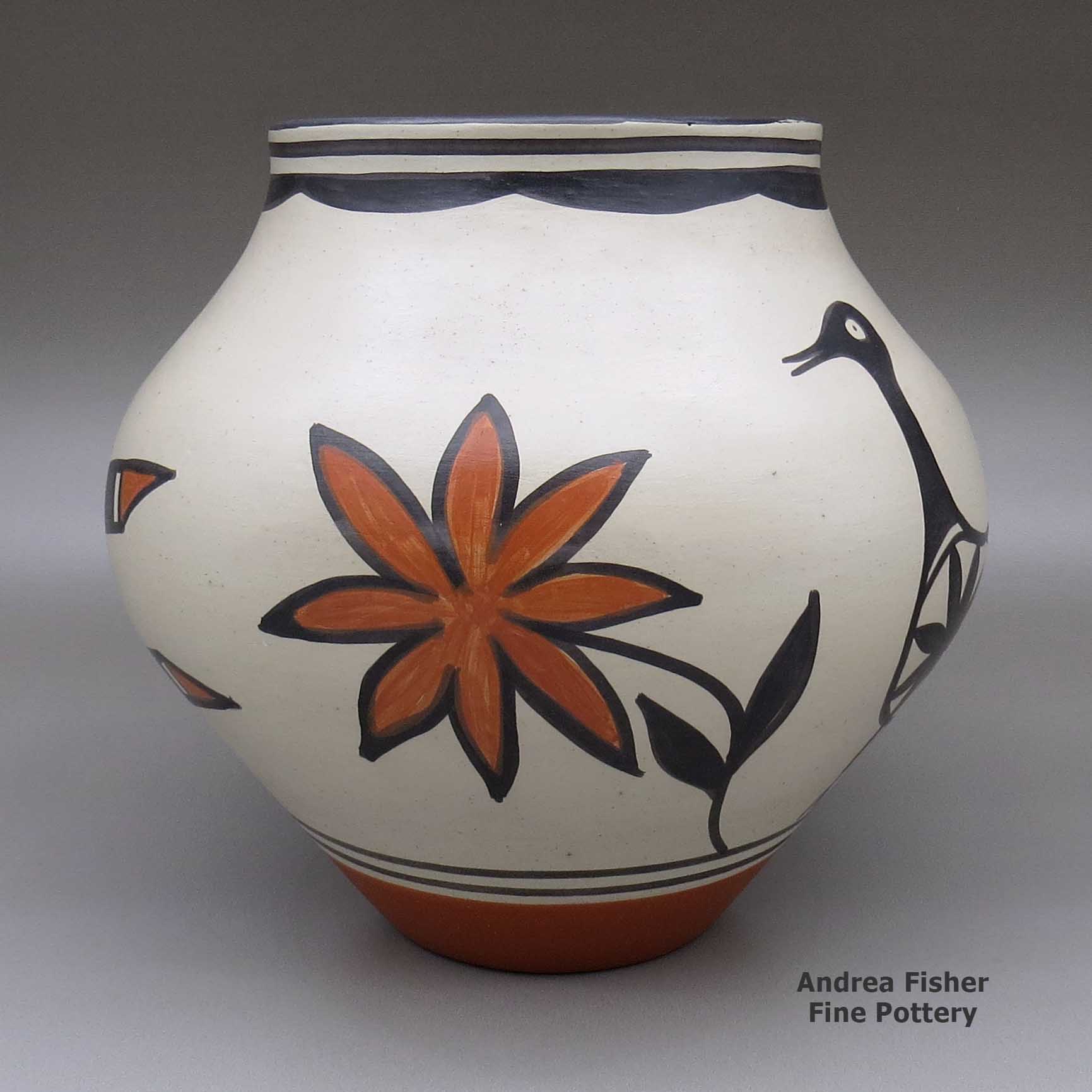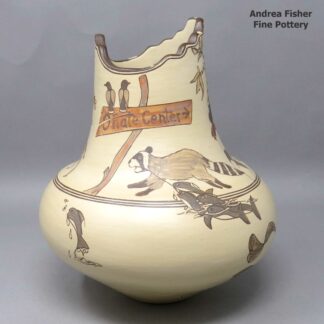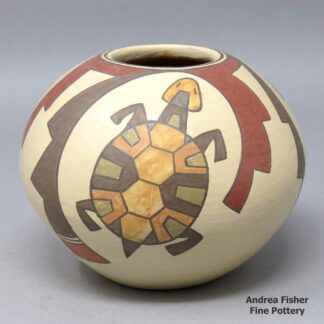| Dimensions | 10.5 × 10.5 × 10.25 in |
|---|---|
| Signature | Ambrose Atencio Kewa |
| Date Born | 2010 |
| Condition of Piece | Very good |
Ambrose Atencio, aasd2f201, Jar with bird, flower and geometric design
$1,150.00
A polychrome jar decorated with a Traditional Santo Domingo bird, flower and geometric design
In stock
Brand
Atencio, Ambrose
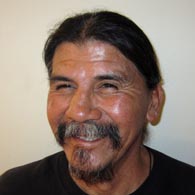 Ambrose Atencio was born to Joseph Ray Atencio and Juanita Atencio of Santo Domingo Pueblo in June, 1963. He told us he learned the traditional method of making pottery from his cousin, Robert Tenorio (and his family), starting around the time Ambrose was 13 years old. The years since then Ambrose has spent perfecting his technique. His progression is reflected in the perfect shape of his pots and in his exquisite execution of the traditional Santo Domingo designs that he chooses to use.
Ambrose Atencio was born to Joseph Ray Atencio and Juanita Atencio of Santo Domingo Pueblo in June, 1963. He told us he learned the traditional method of making pottery from his cousin, Robert Tenorio (and his family), starting around the time Ambrose was 13 years old. The years since then Ambrose has spent perfecting his technique. His progression is reflected in the perfect shape of his pots and in his exquisite execution of the traditional Santo Domingo designs that he chooses to use.He collects the basic materials to make his pottery on the lands of Santo Domingo Pueblo. When his pieces are finished and ready, Ambrose ground fires his work using cottonwood bark, like his grandmother, Crucita Tortalita (Robert Tenorio's maternal aunt), used to do. He's also taught his son Elroy to work with clay in the traditional way.
Ambrose has earned multiple awards at venues such as the Indian Arts Northwest Market in Portland, Oregon, the Fountain Hills Indian Market in Fountain Hills, Arizona, the Eight Northern Indian Pueblos Arts & Crafts Show in Espanola, New Mexico, the Dallas Indian Arts and Crafts Fair in Dallas, Texas, the Santa Fe Indian Market (where he's taken home ribbons for Best of Class, Best of Category and others), and the Heard Museum Guild Indian Art Fair & Market in Phoenix (where he's earned several ribbons).
Ambrose tells us his favorite shapes to make are storage jars and large dough bowls. He also really enjoys decorating them with traditional Santo Domingo birds, plants, animals and geometric designs. Like many Native American traditional potters, he says his inspiration comes from above, through the clay.
When he's not busy making new pots Ambrose says he enjoys hiking. On special occasions he enjoys music concerts, a favorite one having been a Fleetwood Mac concert on his birthday.
He signs his work: "Ambrose Atencio KEWA" and adds the date the pot was created.
Some of the Awards Ambrose has earned
- 2004 Santa Fe Indian Market, Class. II - Pottery, Div. E - Traditional pottery, jars, including wedding jars, Cat. 1204 - Jars, Santo Domingo or Cochiti, Third Place;
- Div. F - Traditional pottery, painted designs on matte or semi-matte surface, all forms except jars, Cat. 1302 - Other bowl forms, Second Place - 2001 Santa Fe Indian Market, Class. II - Pottery, Div. E - Traditional pottery jars, Cat. 1204 - Jars, Santo Domingo or Cochiti, First & Second Place
A Short History of Santo Domingo Pueblo
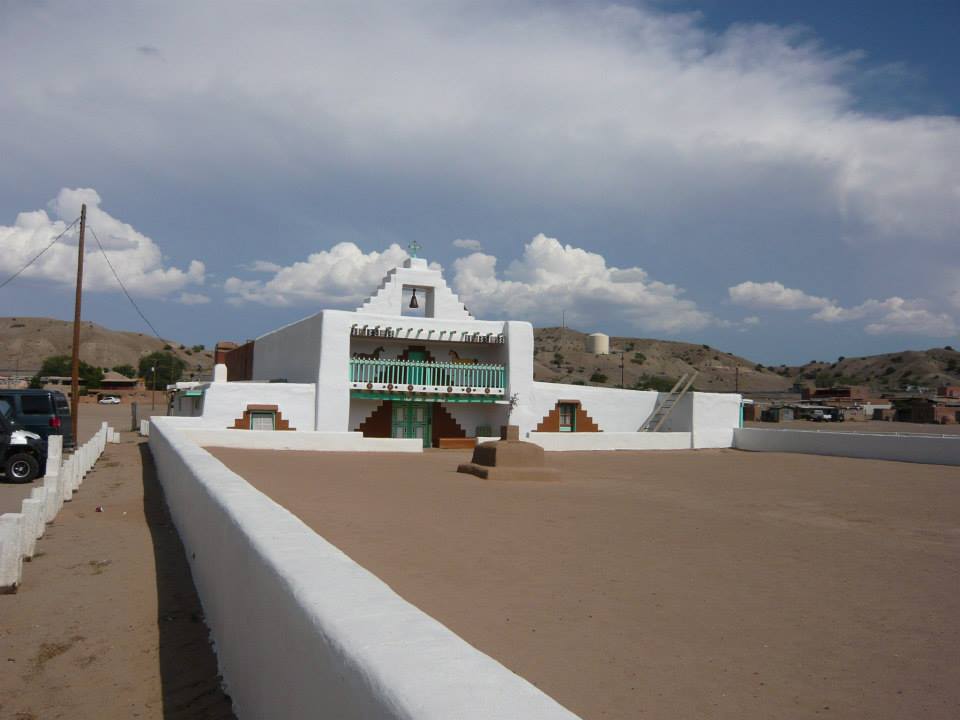
Santo Domingo Pueblo is located on the east bank of the Rio Grande about half-way between Santa Fe and Albuquerque. Historically, the people of Santo Domingo were among the most active of Pueblo traders. The pueblo also has a reputation of being ultra traditional, probably due, at least in part, to the longevity of the pueblo's pottery styles. Some of today's popular designs have changed very little since the 1700's.
In pre-Columbian times, traders from Santo Domingo were trading turquoise (from mines in the Cerrillos Hills) and hand-made heishe beads as far away as central Mexico. Many artisans in the pueblo still work in the old ways and produce wonderful silver and turquoise jewelry and heishe decorations.
Like the people of nearby San Felipe and Cochiti, the people of Santo Domingo speak Keres and trace their ancestry back to villages established in the Pajarito Plateau area in the 1400s. Like the other Rio Grande pueblos, Santo Domingo rose up against the Spanish oppressors in 1680, following Alonzo Catiti as he led the Keres-speaking pueblos and worked with Popé (of San Juan Pueblo) to stop the Spanish atrocities. However, when Spanish Governor Antonio Otermin returned to the area in 1681, he found Santo Domingo deserted and ordered it burned. The pueblo residents had fled to a nearby mountain stronghold and when Don Diego de Vargas returned to Nuevo Mexico in 1692, he attacked that mountain fortress and burned it, too. Catiti died in that battle and Keres opposition to the Spanish crumbled with his death. The survivors of that battle fled, some to Acoma, some to fledgling Laguna, some to the Hopi mesas. Over time most of them returned to Santo Domingo.
In the late 1690s, Santo Domingo accepted an influx of refugees from the Galisteo Basin area as they fled drought and the near-constant attacks of Apache, Comanche, Ute and Navajo raiders in that area.
Today's main Santo Domingo village was founded about 1886.
In 1598 Santo Domingo was the site of the first gathering of 38 pueblo governors by Don Juan de Oñaté. He attempted to force them to swear allegiance to the crown of Spain. Today, the All Indian Pueblo Council (consisting of the nineteen remaining pueblo's governors and an executive staff) gathers at Santo Domingo for their first meeting every year, to continue what is now the oldest annual political gathering in America. During the time of the Spanish occupation, Santo Domingo served as the headquarters of the Franciscan missionaries in New Mexico and religious trials were held there during the Spanish Inquisition.
Today, the people of Santo Domingo number around 4,500 with about two-thirds of them living on the reservation.
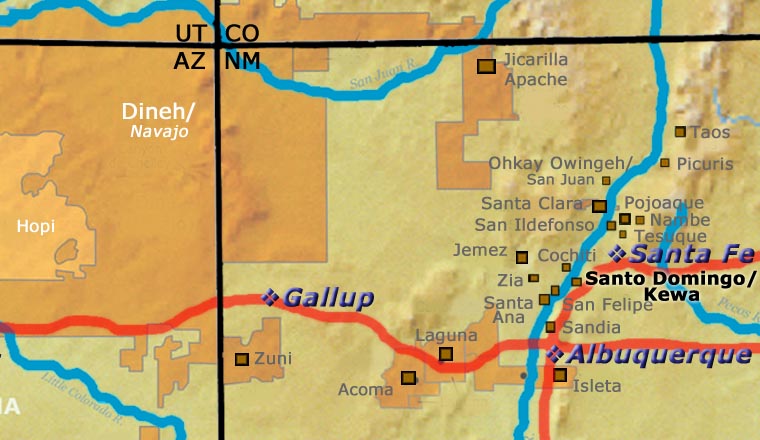
For more info:
Pueblos of the Rio Grande, Daniel Gibson, ISBN-13:978-1-887896-26-9, Rio Nuevo Publishers, 2001
Photo courtesy of Wikimedia Commons, Creative Commons Attribution-Share Alike 3.0 Unported License
Traditional Santo Domingo Design
Santo Domingo is considered a very conservative pueblo, especially when it comes to their religion. Their religion affects every aspect of the people's lives at Santo Domingo. Due to what has happened to them since Coronado and his men first arrived, they have become very secretive in regards to every aspect of their religious practices.
For example, artists are not allowed to depict human forms, especially on products meant for sale to outsiders. That restricts the artist's palette to images of birds, flowers, fish and various geometric patterns symbolizing water, forest, clouds, rain and lightning bolts. There is also a tradition at Santo Domingo of painting their pots completely in the negative using black and red pigments, rather than just painting in black and red on their usual "white" background slip.
Back in the 1920s, Kenneth Chapman, from the Museum of New Mexico, became worried that the Santo Domingo pottery tradition was dying. So he went there and, sitting among the potters, he copied the designs each were painting on their pots and made a book of those. Thomas Tenorio has told us that book is where he got many of his designs from.
About Jars
The jar is a basic utilitarian shape, a container generally for cooking food, storing grain or for carrying and storing water. The jar's outer surface is a canvas where potters have been expressing their religious visions and stories for centuries.
In Sinagua pueblos (in northern Arizona), the people made very large jars and buried them up to their openings in the floors of the hidden-most rooms in their pueblo. They kept those jars filled with water but also kept smaller jars of meat and other perishables inside those jars in the water. It's a form of refrigeration still in use among indigenous people around the world.
Where bowls tend to be low, wide and with large openings, jars tend to be more globular: taller, less wide and with smaller openings.
For a potter looking at decorating her piece, bowls are often decorated inside and out while most jars are decorated only on the outside. Jars have a natural continuity to their design surface where bowls have a natural break at the rim, effectively yielding two design surfaces on which separate or complimentary stories can be told.
Before the mid-1800s, storage jars tended to be quite large. Cooking jars and water jars varied in size depending on how many people they were designed to serve. Then came American traders with enameled metal cookware, ceramic dishes and metal eating utensils...Some pueblos embraced those traders immediately while others took several generations to let them and their innovations in. Either way, opening those doors led to the virtual collapse of utilitarian pottery-making in most pueblos by the early 1900s.
In the 1920s there was a marked shift away from the machinations of individual traders and more toward marketing Native American pottery as an artform. Maria Martinez was becoming known through her exhibitions at various major industrial fairs around the country and Nampeyo of Hano was demonstrating her art for the Fred Harvey Company at the Grand Canyon. The first few years of the Santa Fe Indian Market helped to solidify that movement and propel it forward. It took another couple generations of artists to open other venues for their art across the country and turn Native American art into the phenomenon it has become.
Today's jars are artwork, not at all for utilitarian purposes, and their shapes, sizes and decorations have evolved to reflect that shift.
Tenorio Family Tree - Santo Domingo Pueblo/Kewa
Disclaimer: This "family tree" is a best effort on our part to determine who the potters are in this family and arrange them in a generational order. The general information available is questionable so we have tried to show each of these diagrams to living members of each family to get their input and approval, too. This diagram is subject to change should we get better info.
-
Clemente & Nescita Calabaza (maternal side) & Andrea Ortiz (paternal side)
- Juanita Calabaza Tenorio (1922-1982) & Andres Tenorio
- Luciano Coriz & Marie Edna Coriz (1946-)(Jemez)
- Angel Bailon (1968-) & Ralph Bailon
- Paulita Pacheco (1943-2008) & Gilbert Pacheco (1940-2010)
- William Andrew Pacheco (1975-)
- Rose Pacheco (1968-) & Billy Veale (Navajo)
- Robert Tenorio (1950-)
Among Robert's students:
- Arthur Coriz (1948-1999) & Hilda Coriz (1949-2007)
- Ione Coriz (1973-)
- Warren Coriz (1966-2011)
- Luciano Coriz & Marie Edna Coriz (1946-)(Jemez)
-
Gilbert Pacheco's sisters who became potters:
- Laurencita Calabaza (c.1940s-)
- Santana Calabaza (c.1960s-)
- Trinidad Pacheco (c.1940s-)
- Vivian Sanchez (c.1940s-)
- Laurencita Calabaza (c.1940s-)

